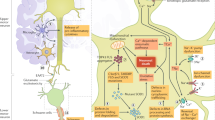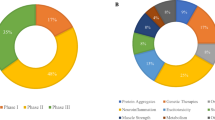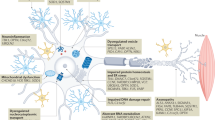Abstract
Because treatments are not yet powerful enough to reverse the symptoms of amyotrophic lateral sclerosis (ALS), randomized placebo-controlled trials remain the gold standard for testing new therapies. To date, only one drug, riluzole, has been shown to slow the course of ALS, albeit in a very modest way. Since the approval of riluzole almost 10 years ago, there have been a number of negative trials, and we still await the discovery of a medication with a truly meaningful effect. With each study, our sophistication in trial design grows, but hurdles remain, including how to use transgenic animal models optimally, which outcome measures most accurately reflect changes in the disease, and how to reduce the often high dropout rates in trials of ALS. This article is devoted to the recent evolution of clinical trials in ALS and discusses specific trials conducted during the past 5 years.
Similar content being viewed by others
References and Recommended Reading
Pascuzzi RM: Blinded and seeing the light, (John Noseworthy), Lou Gehrig and other tales of enlightenment. Semin Neurol 1998, 18:415–418.
Rowland LP, Shneider NA: Amyotrophic lateral sclerosis. N Engl J Med 2001, 344:1688–1700.
Young FE, Norris JA, Levitt JA, Nightingale SL: The FDA’s new procedures for the use of investigational drugs in treatment. JAMA 1988, 25:2267–2270.
Cedarbaum JM, Stambler N: Disease status and use of ventilatory support by ALS patients. BDNF Study Group. Amyotroph Lateral Scler Other Motor Neuron Disord 2001, 2:19–22.
Miller RG, Mitchell JD, Lyon M, Moore DH: Riluzole for amyotrophic lateral sclerosis (ALS)/motor neuron disease (MND). Cochrane Neuromuscular Disease Group. Cochrane Database of Systematic Reviews 2004, 2. This work uses a meta-analysis to analyze the data of three reported randomized trials of a total of 876 patients examining the efficacy of riluzole in ALS. The results indicate that riluzole treatment extends survival by about 2 months.
ALS CNTF Treatment Study (ACTS) Study Group: A doubleblind placebo-controlled clinical trial of subcutaneous recombinant human ciliary neurotrophic factor (rHCNTF) in amyotrophic lateral sclerosis. Neurology 1996, 46:1244–1249.
Cudkowicz ME, Shefner JM, Schoenfeld DA, et al.: Northeast ALS Consortium: A randomized, placebo-controlled trial of topiramate in amyotrophic lateral sclerosis. Neurology 2003, 61:456–464. This large National Institutes of Health-funded trial showed that a readily available medication may worsen the course of ALS. It also brings into question the accepted practice of off-label prescription for patients outside of or after clinical trials.
Miller RG, Moore DH 2nd, Gelinas DF, et al.: Western ALS Study Group: Phase III randomized trial of gabapentin in patients with amyotrophic lateral sclerosis. Neurology 2001, 56:843–848. This large trial provided data on the usefulness of various outcome measures, including survival, MVIC, and the ALSFRS. It also highlighted the need for well-designed early-phase trials.
Sorenson: A Comparison of muscle strength testing techniques in amyotrophic lateral sclerosis. Paper presented at the 12th International Symposium on ALS/MND, Oakland, CA, October, 2001.
A controlled trial of recombinant methionyl human BDNF in ALS: the BDNF study group (phase III). Neurology 1999, 52:1427–1433.
Meininger V, Bensimon G, Bradley WR, et al.: Efficacy and safety of xaliproden in amyotrophic lateral sclerosis: results of two phase III trials. Amyotroph Lateral Scler Other Motor Neuron Disord 2004, 5:107–117.
The ALS CNTF Treatment Study (ACTS) Phase I-II Study Group: The amyotrophic lateral sclerosis functional rating scale. Assessment of activities of daily living in patients with amyotrophic lateral sclerosis. Arch Neurol 1996, 53:141–147.
Cedarbaum JM, Stambler N: Performance of the amyotrophic lateral sclerosis functional rating scale (ALSFRS) in multicenter clinical trials. J Neurol Sci 1997, 152(Suppl 1):S1-S9.
Cedarbaum JM, Stambler N, Malta E, et al.: The ALSFRS-R: a revised ALS functional rating scale that incorporates assessments of respiratory function. BDNF ALS Study Group (Phase II/III). J Neurol Sci 1999, 169:13–21.
Kaufmann P, Levy G, Thompson JL, et al.: The ALSFRSr predicts mortality in an ALS clinic population. Neurology 2004, In press.
Kaufmann P, Pullman SL, Shungu DC, Chan S: Objective tests for upper motor neuron involvement in amyotrophic lateral sclerosis. Neurology 2004, 62:1753–1757.
Bogdanov M, Brown RH, Matson W, et al.: Increased oxidative damage to DNA in ALS patients. Free Radic Biol Med 2000, 29:652–658.
Beal MF, Ferrante RJ, Browne SE, et al.: Increased 3-nitrotyrosine in both sporadic and familial amyotrophic lateral sclerosis. Ann Neurol 1997, 42:644–654.
Simpson EP, Henry YK, Henkel JS, et al.: Increased lipid peroxidation in sera of ALS patients. A potential biomarker of disease burden. Neurology 2004, 62:1758–1765.
Beuche W, Yushchenko M, Mader M, et al.: Matrix metalloproteinase-9 is elevated in serum of patients with amyotrophic lateral sclerosis. Neuroreport 2000, 11:3419–3422.
Houi K, Kobayashi T, Kato S, et al.: Increased plasma TGF-beta1 in patients with ALS. Acta Neurol Scand 2002, 106:299–301.
McComas AJ, Fawcett PR, Campbell MJ, Sica RE: Electrophysiological estimation of the number of motor units within a human muscle. J Neurol Neurosurg Psychiatry 1971, 34:121–131.
Brooks BR, Miller RG, Swash M, Munsat TL, for the World Federation of Neurology Research Group on Motor Neuron Diseases: El Escorial revisited: revised criteria for the diagnosis of amyotrophic lateral sclerosis. Amyotroph Lateral Scler Other Motor Neuron Disord 2000, 1:293–299. This article summarizes the diagnostic criteria currently used in clinical trials of ALS. The criteria have also been generalized for use in clinic populations where they may be less useful.
Gordon PH, Moore DH, Gelinas DF, et al.: Placebo controlled phase I/II studies of minocycline in amyotrophic lateral sclerosis. Neurology 2004, 62:1845–1847.
Mitsumoto H, Chad DA, Pioro EP: Treatment trials. In Amyotrophic Lateral Sclerosis. Edited by Mitsumoto H, Chad DA, Pioro EP. Philadelphia: FA Davis; 1998:329–354.
Palesch YY, Tilley BC, Broaderick JP: Value of a single-arm futility design for Phase II clinical trial of acute stroke therapy. Neurology 2003, 60(Suppl 1):A339.
Bradley WG: The need for double-blind controlled trials in amyotrophic lateral sclerosis. In ALS-From Charcot to the Present and Into the Future. Edited by Rose FC. London; Smith-Gordon; 1994:263–265.
Bensimon G, Lacomblez L, Meininger V: A controlled trial of riluzole in amyotrophic lateral sclerosis. ALS/Riluzole Study Group. N Engl J Med 1994, 330:585–591.
Lacomblez L, Bensimon G, Leigh PN, et al.: Dose-ranging study of riluzole in amyotrophic lateral sclerosis. Amyotrophic lateral sclerosis/riluzole study group II. Lancet 1996, 347:1425–1431.
Groeneveld GJ, Veldink JH, van der Tweel I, et al.: A randomized sequential trial of creatine in amyotrophic lateral sclerosis. Ann Neurol 2003, 53:437–445. This trial broke new ground in the design of late-phase trials in ALS. It used a sequential monitoring system in which survival data were continuously monitored by an independent statistician. Once adequate numbers of patients in the creatine arm had died and the null hypothesis of no effect could no longer be rejected statistically, the trial was stopped, which reduced both time and expense. The trial also had one of the lowest dropout rates of any ALS trial conducted to date.
Smith RA, Berg JE, Pope LE, Thisted RA: Measuring pseudobulbar affect in amyotrophic lateral sclerosis. Amyotroph Lateral Scler Other Motor Neuron Disord 2004, In press.
Mitsumoto H, Davidson M, Moore D, et al.; ALS CARE Study Group: Percutaneous endoscopic gastrostomy (PEG) in patients with ALS and bulbar dysfunction. Amyotroph Lateral Scler Other Motor Neuron Disord 2003, 4:177–185.
Miller RG, Rosenberg JA, Gelinas DF, et al.: Practice parameter: the care of the patient with amyotrophic lateral sclerosis (an evidence-based review): report of the Quality Standards Subcommittee of the American Academy of Neurology: ALS Practice parameters Task Force. Neurology 1999, 52:1311–1323.
Janson CG, Ramesh TM, During MJ, et al.: Human intrathecal transplantation of peripheral blood stem cells in amyotrophic lateral sclerosis. J Hematother Stem Cell Res 2001, 10:913–915.
Mazzini L, Fagioli F, Boccaletti R, et al.: Stem cell therapy in amyotrophic lateral sclerosis: a methodological approach in humans. Amyotroph Lateral Scler Other Motor Neuron Disord 2003, 4:158–161.
Kriz J, Nguyen MD, Julien JP: Minocycline slows disease progression in a mouse model of amyotrophic lateral sclerosis. Neurobiol Dis 2002, 10:268–278.
Van Den Bosch L, Tilkin P, Lemmens G, Robberecht W: Minocycline delays disease onset and mortality in a transgenic model of ALS. Neuroreport 2002, 13:1067–1070.
Zhu S, Stravrovskaya IG, Drozda M, et al.: Minocycline inhibits cytochrome c release and delays progression of amyotrophic lateral sclerosis in mice. Nautre 2002, 417:74–78.
Haynes RB, Dantes R: Patient compliance and the conduct and interpretation of therapeutic trials. Control Clin Trial 1987, 8:12–19.
Author information
Authors and Affiliations
Rights and permissions
About this article
Cite this article
Gordon, P.H. Advances in clinical trials for amyotrophic lateral sclerosis. Curr Neurol Neurosci Rep 5, 48–54 (2005). https://doi.org/10.1007/s11910-005-0023-2
Issue Date:
DOI: https://doi.org/10.1007/s11910-005-0023-2




